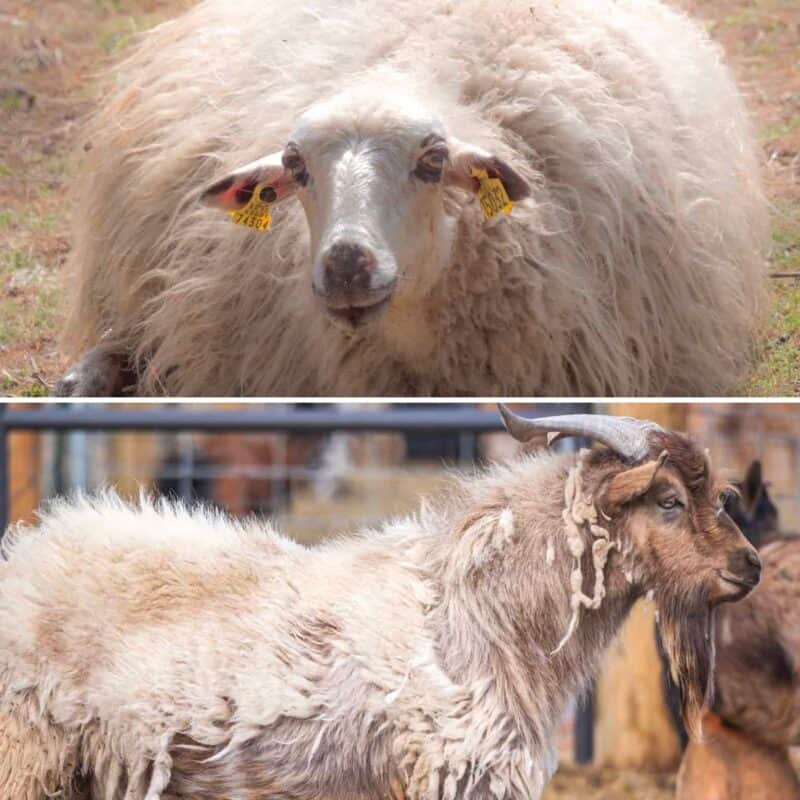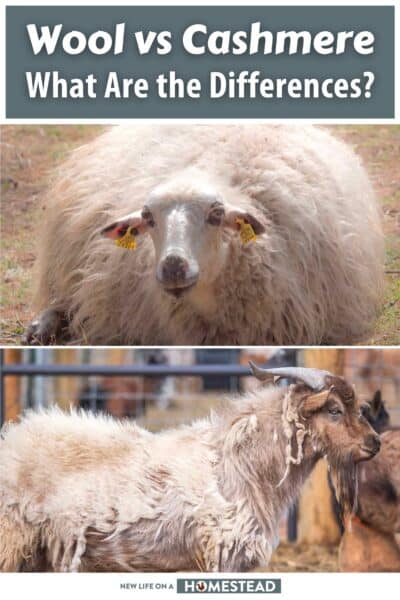By now I think most folks know that wool has many advantages as a fabric. Supremely insulating, durable, fire retardant and capable of keeping you warm even when soaking wet.

What’s not to like? If you like that, you’re going to love cashmere. Cashmere is usually treated like the cream of the crop as far as wool is concerned.
But are there differences between the two? Is it just a matter of quality or something else? What’s the difference between wool and cashmere exactly?
Cashmere is a type of wool made from the undercoat of rare cashmere goats. It is far warmer, lighter, softer and thinner than wool, but more expensive and it requires more specialized maintenance.
Cashmere actually comes from goats, not sheep, as mentioned and is much, much nicer overall compared to standard sheep’s wool garments.
That being said, there’s certainly room for both in your wardrobe, but you’ll need to do a careful comparison before you decide whether cashmere is worth the extra coin.
Keep reading and I’ll tell you everything you need to know…
| Cashmere | Wool | |
|---|---|---|
| Source | From cashmere goats | From goats, sheep, rabbits, etc. |
| Fiber Thickness | Thinner and finer | Thicker and coarser |
| Durability | More durable | Less durable |
| Price | More expensive | Less expensive |
| Can cause allergies | Yes | Yes |
What is Cashmere Made From?
Cashmere is made from the soft undercoat of cashmere (sometimes spelled kashmir) goats. These goats are known for their “double fleece” consisting of a coarser outer layer and a fine, almost downy underlayer.
It’s this underlayer that’s harvested to produce cashmere. This process involves combing the goat rather than shearing it, ensuring only the finest fibers are collected.
The result is an incredibly unique, soft, and fine texture compared to normal wool.
Compared to regular wool, cashmere is superior in many regards and highly coveted. It’s this special nature and quality that sets it apart from common sheep’s wool, and what makes it one of the most luxurious and coveted types of wool you can find…
Is Cashmere Considered Wool?
Yes, cashmere is a type or subset of wool. Wool is often thought of as coming specifically from sheep, and much of the time, that is true.
But wool can technically come from various other animal species, among them alpacas, llamas, rabbits, and of course goats. More on that in a minute.
Is Cashmere Warmer than Wool?
Yes! When it comes to wool warmth, cashmere reigns supreme. It’s been found that cashmere can be anywhere from six to eight times warmer than merino wool, itself a high-quality sheep’s wool.
This is due to its inherently superior insulating properties, which stem from the high loft of the fibers.
This characteristic means two things for you, practically…
You can stay just as warm in any given conditions with cashmere using a much smaller and thinner garment, or you can use a thicker cashmere garment to stay toasty warm and comfortable even in the most blisteringly cold places.
Cashmere is used for both casual wear and traditional deep-cold outdoor gear for this reason.
Advantages of Cashmere
Besides its superior warmth and softness, cashmere has a few other advantages. First, it’s extremely lightweight compared to typical wool, which makes your cashmere sweater or scarf feel feathery while still providing excellent warmth in all conditions.
Second, cashmere has a unique crimp that makes it more flexible and thinner compared to most traditional kinds of sheep wool.
In regards to fashion, this results in superior drape and fit compared to most other types of wool.
For more utilitarian purposes, this means that it’s less bulky while still yielding excellent thermal properties, meaning that your cashmere garment is more flexible literally and figuratively.
It can be worn more easily as an under or mid layer, and it might be the only garment you need to stay safe and comfortable.
Finally, cashmere is very hypoallergenic, making it a great choice for those with sensitive skin or known wool- or other animal hair allergies.
What is Most Other Wool Made From?
Most wool is made from the fleece of sheep. During the shearing process, the fleece is removed from the sheep in one piece, then cleaned and processed into yarn which becomes wool.
The texture and quality of the wool can vary greatly depending on the breed of sheep it comes from.
For example, Merino wool, known for its exceptional softness (for sheep fleece), comes from Merino sheep. No, it isn’t a branded or trademarked fabric!
Just a special breed of sheep. While coarser, wool suitable for carpeting or other utilitarian textiles may come from any number of different breeds, or a blend of wool from various breeds.
Does All Wool Come from Sheep?
While the word “wool” is inextricably linked with sheep in the minds of most folks, not all wool comes from these animals. In fact, wool can come from a variety of sources.
Mohair and cashmere, for example, come from goats. Alpaca wool is harvested from, of course, alpacas, while angora wool comes from rabbits.
Each type of wool has its own unique characteristics as cashmere does. For instance, the lustrous shine of mohair or the versatility and plushness of angora.
Alpaca wool is loved for its sheer versatility. So, while sheep are the most common source, the world of wool is far more diverse than you’d think.
What are the Advantages of Wool?
When it comes to staying warm no matter the conditions, wool is your best friend. This natural fiber has an incredible ability to regulate temperature, keeping you comfortable in both hot and cold weather.
This is owed to wool’s unique fibers that trap air close to your body while wicking away excess heat and moisture.
It also acts as a thermal barrier, keeping the heat out and the body of the wearer cooler whe it is warm.
Additionally, wool is known for its durability and resistance, meaning your favorite woolen sweater or blanket will last for years to come if given just a little bit of proper care.
There are things like wool blankets that have been in some families for generations and are nearly as good as they were when they were new.
Even more important is that wool maintains its thermal barrier properties even when soaking wet. Yes, a wool blanket or wool sweater that has been soaked can still keep you warm.
What are the Disadvantages of Wool?
For one, wool garments are more expensive than those made from other natural and synthetic materials. They also require special care when washing to prevent shrinking or damage.
Certain wool types are also notorious for feeling itchy against the skin, particularly if it’s not a softer variety like Merino, or one made to a higher standard by skilled craftsmen.
Some people also allegedly have wool allergies, which means it can cause skin irritation, itchy eyes and more. Bummer!
Supposedly this has more to do with the quality of the wool rather than any inherent characteristic of the material, but I am unconvinced.
So Does Cashmere Have Any Drawbacks?
Cashmere, as said, is virtually unbeatable when it comes to softness and warmth, and “the best” certainly has its own special appeal no matter who is buying. However, this wonder wool is not without its downsides, too.
Like wool, cashmere clothing tends to be more expensive, but even more so due to its rarity and the labor-intensive process to harvest and produce it.
You are always going to spend a significant premium to get any garment or item made from cashmere.
Cashmere also requires delicate handling and care above and beyond what wool requires. It should, generally, only be hand-washed and laid flat to dry to maintain its shape and quality. Mistreatment will quickly degrade delicate cashmere!
Also, cashmere is just not as durable as traditional wool, all things equal, as it can pill significantly over time with wear and washing.
This means it isn’t the best choice for truly utilitarian or hard-use gear that might be exposed to the elements or to a lot of rough treatment.
Cashmere might feel, and indeed is, luxurious but it does require a bit more effort and a lot more money if you want to make use of it.

Tom has lived and worked on farms and homesteads from the Carolinas to Kentucky and beyond. He is passionate about helping people prepare for tough times by embracing lifestyles of self-sufficiency.
